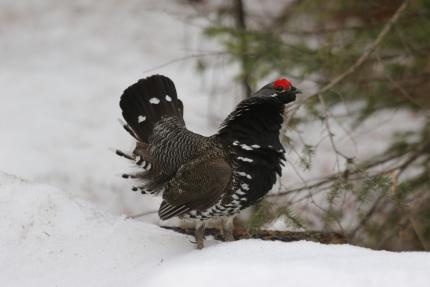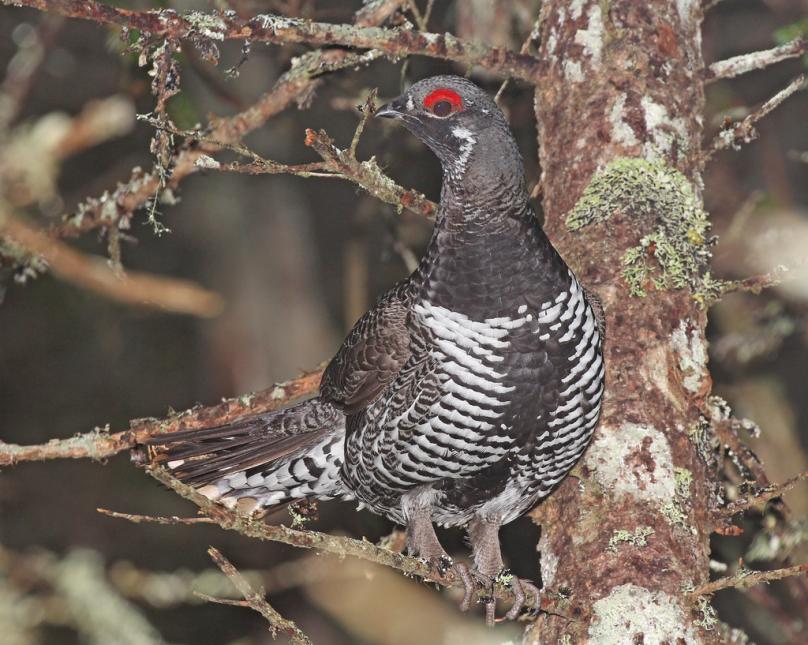High
Although the spruce grouse is a gamebird, the indirect effects of climate change including disease of trees and wildfire, the direct effects of certain timber harvest practices, and the uncertainty about taxonomy mean that this species' conservation status is unclear.
Spruce grouse are managed as upland game birds. For current rules about hunting spruce grouse in the state, be sure to check the Washington Game Bird and Small Game hunting regulations.
Description and Range
Physical description
Spruce grouse are about 16 inches long. Males have a scarlet eye comb, and a black throat and black breast patch. Females are basically mottled brown in color. Both sexes have dark, unbarred tailfeathers with brown tips.
Ecology and life history
Spruce grouse depend on conifer forests, especially fire-adapted lodgepole pine, but also spruce and fir. Greatest densities appear to be in young successional stands of dense lodgepole pine, with a well-developed middle and understory of spruce, fir, and/or deciduous shrubs. Spruce grouse living in fragmented habitats have lower survival.

Populations close to the crest of the Cascades live in habitats with greater tree diversity, but these populations are poorly understood.
Spruce grouse dwell mostly in trees from late autumn through early spring and on the ground from late spring through early autumn.
Grouse forage in winter primarily on lodgepole pine needles, and secondarily on spruce needles.
Both males and females are territorial during the spring. Nesting and brood-rearing females often use small riparian meadows and forest openings. Females generally produce a clutch of five to six eggs. Nest and brood success are usually not very high, but are compensated for with relatively high adult survival.
Geographic range
Spruce grouse are distributed throughout the boreal forest of Canada and Alaska and small portions of other northern states. Most evidence suggests that this grouse consists of types that are genetically, phenotypically, and behaviorally distinct, and taxonomic reclassification may occur at some point in the future.
In Washington, they are primarily found on the east slope of the Cascades from the U.S.-Canada border south to Yakima County and in Okanogan, Ferry, Stevens, and Pend Oreille Counties. Cascade populations are believed to be relatively sparse and discontinuous while populations in the Okanogan highlands have historically been abundant and continuous.
Spruce grouse have declined in many portions of northern Washington due to wildfires between 1994 and 2014. The Washington population is approximately 5,000 individuals.
For a map of range-wide distribution and conservation status of spruce grouse, check out NatureServe Explorer.
Climate vulnerability
Sensitivity to climate change
Moderate-
High
Sensitivity of spruce grouse appears to be driven by their dependence on high elevation conifer forests (in Washington, particulary Lodgepole Pine). Spruce grouse prefer relatively young successional stands of dense conifers, and populations appear to fluctuate over time in response to the degree of maturation of post-fire regrowth. Altered fire regimes and insect and disease outbreaks that lead to habitat degradation increase the sensitivity of spruce grouse to climate change; species has sustained substantial loss of suitable habitat condition in Washington.
Exposure to climate change
High
- Altered fire regimes
- Increased insect and disease outbreaks
Regulations
Rules and seasons
For current rules about hunting spruce grouse in the state, be sure to check the Washington Game Bird and Small Game hunting regulations.
Conservation
Conservation Threats and Actions Needed
- Invasive and other problematic species and genes
- Threat: Increased fire size resulting from beetle infestations
- Action Needed: Fire management
- Agriculture and aquaculture side effects
- Threat: Salvage harvest in areas impacted by beetle infestations
- Action Needed: Develop and implement best management practices
- Resource information collection needs
- Threat: Lack of population data poses risk of over-harvesting
- Action Needed: Monitor annual harvest
- Climate change and severe weather
- Threat: Beetle infestations due to climate temperature change killing lodgepole pine, spruce and fir trees
- Action Needed: Forest management
See the Climate vulnerability section for more information about the threats posed by climate change to this species.
Resources
References
Boag, D. A., and M. A. Schroeder. 1991. Spruce grouse (Falcipennis canadensis). Birds of North America 5: 1-28.
Boag, D. A., and M. A. Schroeder. 1987. Population fluctuations in spruce grouse: what determines their numbers in spring? Canadian Journal of Zoology 65:2430-2435.


.jpg?crop=no&k=c&w=860&h=645)


